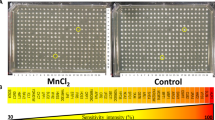Abstract
Manganese (Mn) is crucially important for vital activity of cells and has many biological functions. Nevertheless, high doses of Mn taken up by an organism over a long period may cause neurodegenerative diseases such as manganism and Parkinsonism. The molecular mechanisms of this Mn toxicity are still poorly studied. It is now believed that Mn-induced pathophysiological neural processes are multifaceted and affect several metabolic pathways. In particular, Mn ions might affect the processes of DNA replication and repair. To test this possibility, we obtained an SKOV-3 cell line resistant to the toxic action of Mn ions. We found that these cells are characterized by the activation of poly(ADP-ribose)polymerase, which leads to increased ability to repair DNA. Thus, the model used here supports the suggestion that at least one cause of Mn cytotoxicity might be disorders of the processes involved in DNA replication and repair.
Similar content being viewed by others
Abbreviations
- DTT:
-
dithiothreitol
- misGvA:
-
misincorporation of G versus A
- MTT:
-
3-(4,5-dimethylthiazol-2-yl)-2,5-diphenyltetrazolium bromide
- PAR:
-
poly(ADP-ribose)
- PARP-1:
-
poly(ADP-ribose)polymerase-1
- Pol ι:
-
DNA polymerase iota.
References
Santamaria, A. B., and Sulsky, S. I. (2010) Risk assessment of an essential element: manganese, J. Toxicol. Environ. Health, 73, 128–155.
Roth, J. A. (2014) Correlation between the biochemical pathways altered by mutated Parkinson-related genes and chronic exposure to manganese, Neurotoxicology, 44, 314–325.
Integrated Risk Information System (IRIS) (1996) United States Environmental Protection Agency (USEPA).
Toxicological Profile for Manganese (2000) United States Department of Health and Human Services, Agency for Toxic Substances and Disease Registry (ATSDR).
Zhang, F., Xu Z., Gao, J., Xu, B., and Deng, Y. (2008) In vitro effect of manganese chloride exposure on energy metabolism and oxidative damage of mitochondria isolated from rat brain, Environ. Toxicol. Pharmacol., 26, 232–236.
Zhang, S., Fu, J., and Zhou, Z. (2004) In vitro effect of manganese chloride exposure on reactive oxygen species generation and respiratory chain complexes activities of mitochondria isolated from rat brain, Toxicol. in vitro, 18, 71–77.
El-Deiry, W. S., Downey, K. M., and So, A. G. (1984) Molecular mechanisms of manganese mutagenesis, Proc. Natl. Acad. Sci. USA, 81, 7378–7382.
Frank, E. G., and Woodgate, R. (2007) Increased catalytic activity and altered fidelity of human DNA polymerase iota in the presence of manganese, J. Biol. Chem., 282, 2468924696.
Bornhorst, J., Ebert, F., Hartwig, A., Michalke, B., and Schwerdtle, T. (2010) Manganese inhibits poly(ADP-ribosyl)ation in human cells: a possible mechanism behind manganese-induced toxicity, J. Environ. Monitor., 12, 2062–2069.
Lakhin, A. V., Efremova, A. S., Makarova, I. V., Grishina, E. E., Shram, S. I., Tarantul, V. Z., and Gening, L. V. (2013) Effect of Mn(II) on erroneous activity of DNA polymerase iota in the extracts of normal and tumor human cells, Mol. Genet. Mikrobiol. Virusol., 1, 14–20.
Makarova, A. V., Grabow, C., Gening, L. V., Tarantul, V. Z., Tahirov, T. H., Bessho, T., and Pavlov, Y. I. (2011) Inaccurate DNA synthesis in cell extracts of yeast producing active human DNA polymerase iota, PLoS One, 6, e16612.
Torgasheva, N. A., Menzorova, N. I., Sibirtsev, Y. T., Rasskazov, V. A., Zharkov, D. O., and Nevinsky, G. A. (2016) Base excision DNA repair in the embryonic development of the sea urchin Strongylocentrotus intermedius, Mol. Biosyst., 12, 2247–2256.
Quintanar, L. (2008) Manganese neurotoxicity: a bioinorganic chemist’s perspective, Inorg. Chim. Acta, 361, 875884.
Beckman, R. A., Mildvan, A. S., and Loeb, L. A. (1985) On the fidelity of DNA replication: manganese mutagenesis in vitro, Biochemistry, 8, 5810–5817.
Bhanot, O. S., and Solomon, J. J. (1994) The role of mutagenic metal ions in mediating in vitro mispairing by alkylpyrimidines, Environ. Health Perspect., 102, 81–90.
Lakhin, A. V., Tarantul, V. Z., and Gening, L. V. (2014) Manganese-induced incorrect DNA synthesis as a possible cause of manganism, Mol. Genet. Mikrobiol. Virusol., 1, 1521.
Martire, S., Mosca, L., and D’Erme, M. (2015) PARP-1 involvement in neurodegeneration: a focus on Alzheimer’s and Parkinson’s diseases, Mech. Ageing Dev., 146, 53–64.
Love, S., Barber, R., and Wilcock, G. K. (1999) Increased poly(ADP-ribosyl)ation of nuclear proteins in Alzheimer’s disease, Brain J. Neurol., 122, 247–253.
Dawson, V. L., and Dawson, T. M. (1996) Nitric oxide neurotoxicity, J. Chem. Neuroanat., 10, 179–190.
Cosi, C., Chopin, P., and Marien, M. (1996) Benzamide, an inhibitor of poly(ADP-ribose)polymerase, attenuates methamphetamine-induced dopamine neurotoxicity in the C57B1/6N mouse, Brain Res., 735, 343–348.
Wang, H., Shimoji, M., Yu, S. W., Dawson, T. M., and Dawson, V. L. (2003) Apoptosis inducing factor and PARP-mediated injury in the MPTP mouse model of Parkinson’s disease, Ann. N. Y. Acad. Sci., 991, 132–139.
Wu, X. L., Wang, P., Liu, Y. H., and Xue, Y. X. (2014) Effects of poly(ADP-ribose)polymerase inhibitor 3aminobenzamide on blood-brain barrier and dopaminergic neurons of rats with lipopolysaccharide-induced Parkinson’s disease, J. Mol. Neurosci., 53, 1–9.
Author information
Authors and Affiliations
Corresponding author
Additional information
Original Russian Text © K. A. Zakharcheva, L. V. Gening, K. Yu. Kazachenko, V. Z. Tarantul, 2017, published in Biokhimiya, 2017, Vol. 82, No. 1, pp. 101-110. Originally published in Biochemistry (Moscow) On-Line Papers in Press, as Manuscript BM16-222, November 14, 2016.
Rights and permissions
About this article
Cite this article
Zakharcheva, K.A., Gening, L.V., Kazachenko, K.Y. et al. Cells resistant to toxic concentrations of manganese have increased ability to repair DNA. Biochemistry Moscow 82, 38–45 (2017). https://doi.org/10.1134/S0006297917010047
Received:
Accepted:
Published:
Issue Date:
DOI: https://doi.org/10.1134/S0006297917010047




